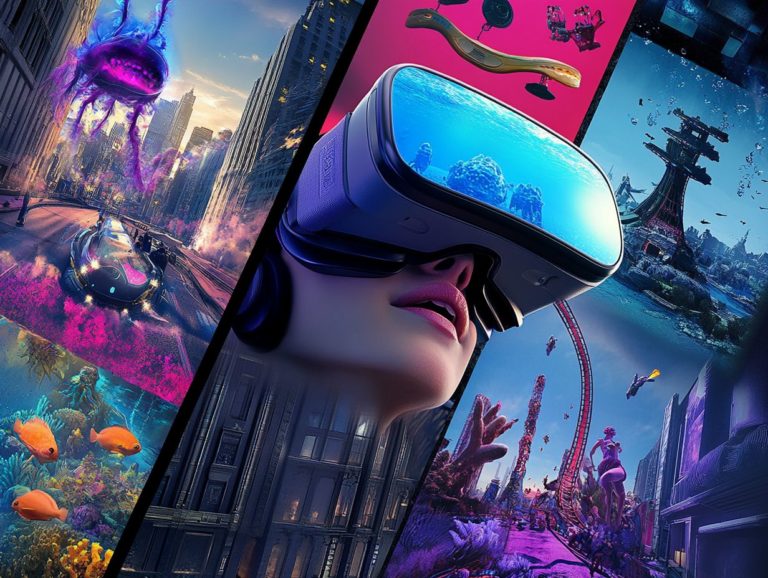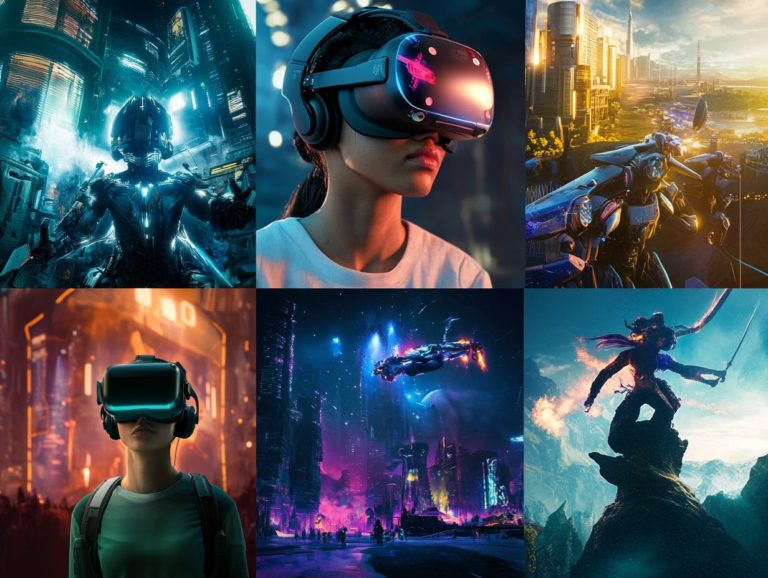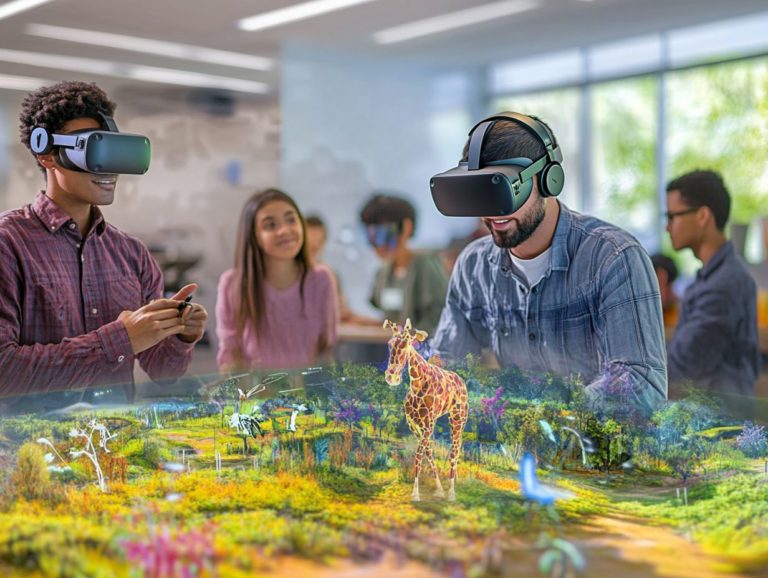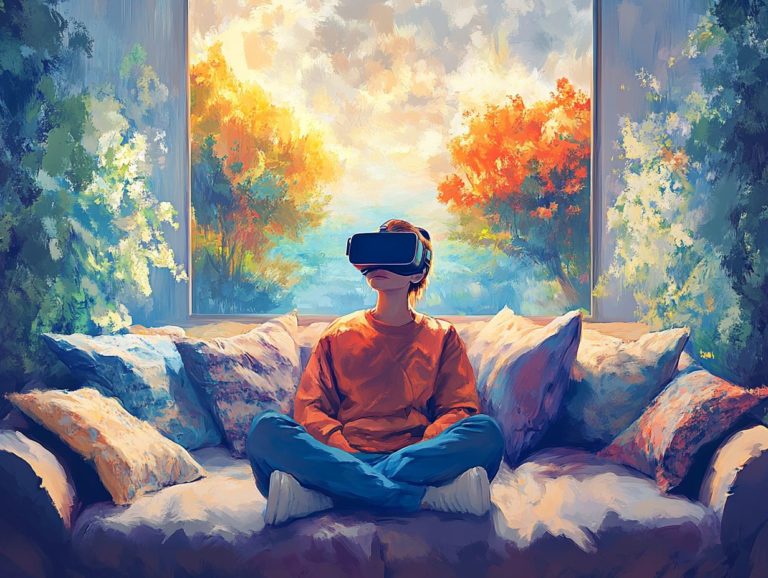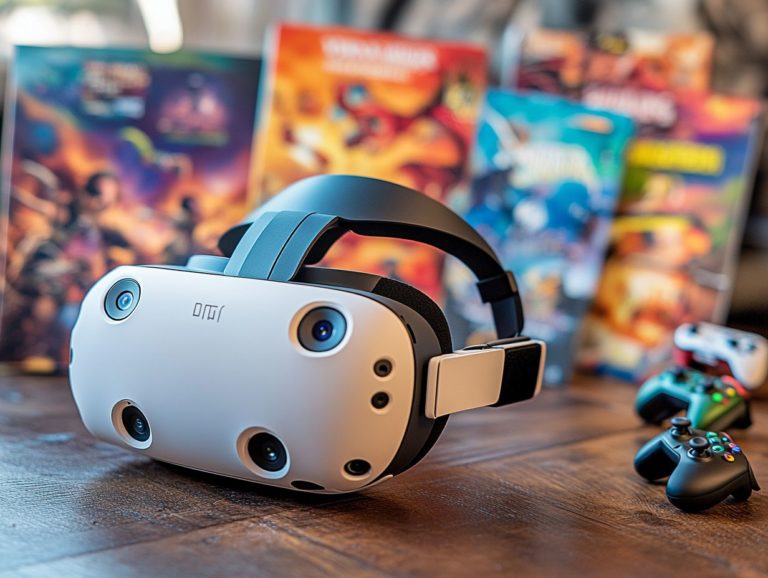the science behind vr immersion
Virtual Reality (VR) immersion is revolutionizing the way you engage with digital environments, seamlessly blending the boundaries between reality and simulation.
This exploration invites you to delve into the science behind VR immersion, revealing how technology interacts with your brain to craft captivating experiences. It highlights the myriad benefits of this immersive technology, from therapeutic applications to enhancements in cognitive and emotional well-being.
Additionally, it addresses the challenges and ethical considerations that accompany this innovation, providing you with insights into future advancements poised to redefine its applications.
Embark on this journey through the fascinating world of VR immersion and discover what awaits!
Contents
- Key Takeaways:
- What is VR Immersion?
- The Science behind VR Immersion
- Benefits of VR Immersion
- Impact on Cognitive and Emotional States
- Challenges and Limitations of VR Immersion
- Technical and Ethical Considerations
- Future of VR Immersion
- Frequently Asked Questions
- What is virtual reality immersion and how does it work?
- What is the science behind VR immersion?
- How does VR immersion affect our perception of reality?
- What are the benefits of experiencing VR immersion?
- Are there any risks or potential negative effects of VR immersion?
- How is VR immersion technology evolving and improving?
Key Takeaways:

- VR immersion means fully engaging in a virtual environment using advanced technology.
- It benefits therapy and education, positively impacting our thoughts and feelings.
- Challenges include technical issues and ethical concerns.
What is VR Immersion?
Virtual Reality (VR) immersion offers you a transformative experience, enabling you to engage with computer-generated images and environments that feel strikingly real and compelling.
You can immerse yourself in this captivating realm through advanced VR technology, often delivered via head-mounted displays such as Oculus Rift or HTC Vive. These devices create a 3D environment where you can interact with digital content as if you were truly a part of it.
By incorporating sensory feedback think visual cues and spatial audio VR immersion elevates your interaction and sense of presence, fostering a deep connection with virtual worlds that leaves a lasting impression.
The Science behind VR Immersion
The science behind VR immersion seamlessly blends intricate principles of how we think and perceive with cutting-edge VR technology to deliver an exceptional user experience.
Immersive environments utilize real-time rendering, motion tracking, and sensory feedback to fully engage you, skillfully altering your perception of reality. This enriches your interactions within virtual realms.
This interdisciplinary approach taps into psychology, neuroscience, and computer technology, optimizing user engagement and enhancing the measurement of presence, ultimately redefining the way you connect with digital content.
How VR Technology Works
VR technology seamlessly blends head-mounted displays, graphical rendering, and sophisticated software applications to create experiences that truly immerse you.
When you slip on a head-mounted display like the Oculus Rift or HTC Vive, you’re met with screens that deliver stunning visuals directly to your eyes, while advanced graphical rendering crafts realistic virtual environments.
Coupled with motion tracking and spatial audio, these elements come together to forge an interactive and engaging experience.
Microphones and sensors elevate this technology even further by capturing your movements and sounds, allowing for a more intuitive interaction with the virtual realm. Exciting software applications enhance this immersive experience, exemplified by gaming platforms like Beat Saber or educational tools like Google Expeditions.
The integration of AI allows for adaptive learning and a personalized user interface, making VR systems not only effective but also remarkably versatile across diverse fields such as training, entertainment, and therapy.
Are you ready to dive into the world of VR?
The Role of the Brain in Immersion

The brain plays a key role in your immersion in virtual reality. It interprets sensory feedback to create a genuine sense of presence in digital environments.
This immersive experience relies on your brain s ability to process visual and auditory cues. It makes you feel as though you re truly interacting with content in a three-dimensional space.
Understanding your brain’s reactions to these stimuli is crucial. This knowledge helps enhance engagement and optimize VR systems for training and learning.
Perception in VR taps into various brain processes. It combines sight and sound, sometimes tricking your mind into believing you re in a different reality.
For example, in gaming, when you hear footsteps behind you, your brain processes that sound with visual cues. This significantly increases your sense of urgency and immersion.
In educational VR, you can manipulate anatomical structures or explore historical models. This activates cognitive principles like spatial awareness and memory recall, leading to deeper learning.
Such elements elevate your experience and produce measurable outcomes across various fields.
Benefits of VR Immersion
VR immersion offers numerous benefits across many fields. These include therapeutic applications, educational simulations, and immersive learning experiences that enhance user engagement.
In healthcare, for instance, VR provides essential training for complex procedures. Professionals can practice skills and patient interactions in realistic environments.
In education, VR creates engaging learning experiences. Students can explore historical landmarks and real-world scenarios in ways traditional methods cannot match.
Therapeutic and Educational Uses
VR has tremendous therapeutic potential in healthcare. It offers immersive environments for training and patient rehabilitation.
Tailored VR experiences allow healthcare professionals to practice complex procedures and navigate real-world scenarios effectively.
In education, VR transforms learning. It facilitates simulations that help students engage with material meaningfully, leading to improved retention.
For example, consider a surgical simulation where medical students operate on virtual patients. This refines their skills and boosts confidence before entering the operating room.
VR therapy also shows promise for patients with anxiety disorders. Gradually exposing them to their fears in a controlled environment encourages desensitization and coping strategy development.
These applications illustrate how VR technology enhances training and elevates learning outcomes for both healthcare professionals and patients.
Impact on Cognitive and Emotional States
The impact of VR immersion on your cognitive and emotional states is remarkable. It fundamentally alters how you process information and engage with content.
Immersive learning experiences leverage cognitive principles to deepen your understanding. Additionally, the emotional engagement created by realistic environments significantly boosts your motivation and retention.
By measuring your emotional states during VR interactions, developers can customize experiences that resonate with you on a deeper level, maximizing cognitive benefits.
Understanding the nuances of your interactions with virtual environments provides essential insights into the mental and emotional currents driving your learning. Recognizing patterns in emotional responses enhances the creation of tailored educational experiences. It also guides creators in crafting scenarios that evoke the desired emotional engagement.
This continuous feedback loop of engagement and emotional evaluation enables designers to refine VR applications, ensuring they are both informative and transformative. As they harness this data, future VR experiences will deliver even richer, more personalized learning journeys that nurture your knowledge and emotional well-being.
Challenges and Limitations of VR Immersion
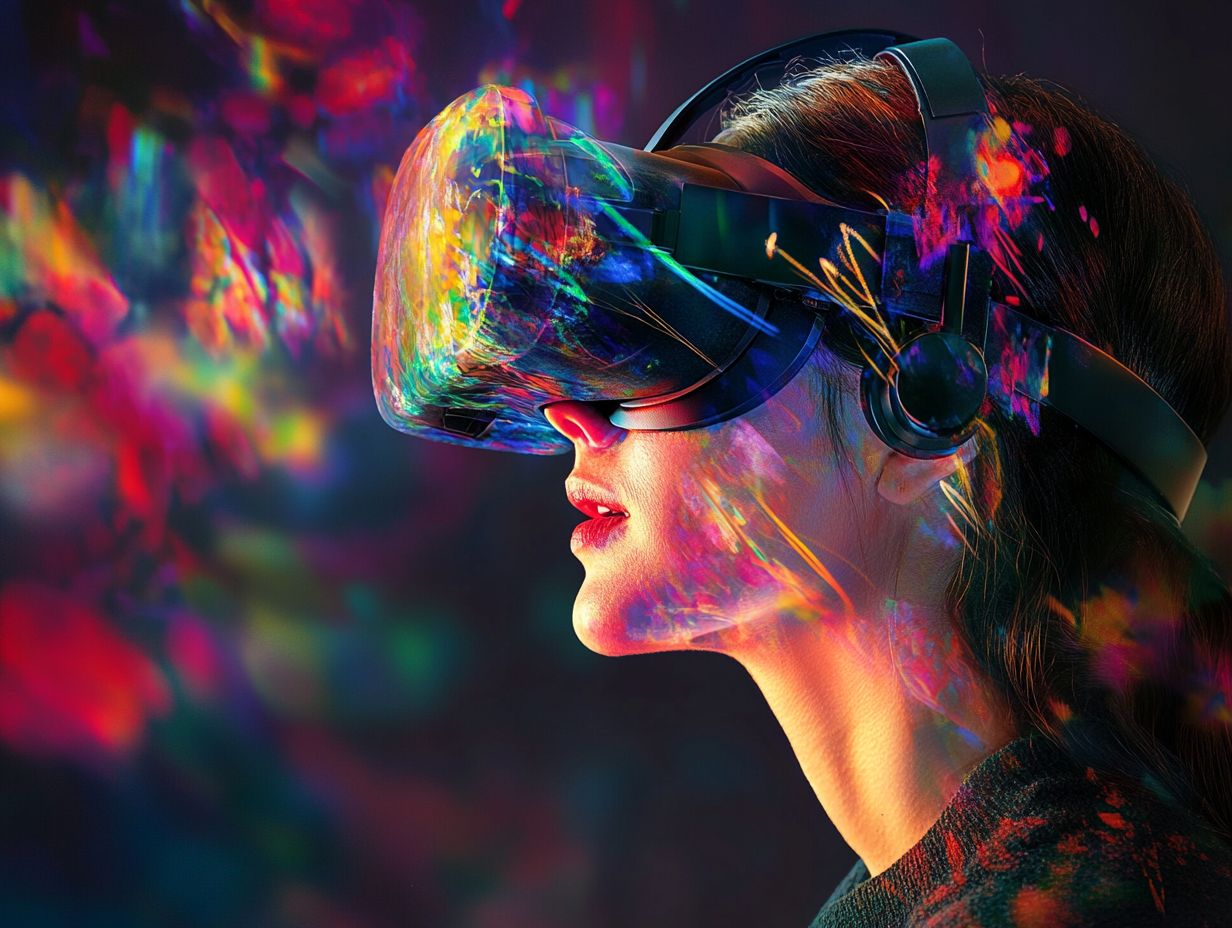
While VR immersion offers many advantages, it also presents challenges and limitations. Issues such as discomfort or nausea, known as cybersickness, can significantly impact your user experience.
It’s common for users to feel disoriented when interacting with VR technology, prompting ethical considerations around accessibility and inclusivity. The swift evolution of technology requires continual assessment of the risks and benefits associated with VR systems to ensure a truly enriching experience.
Technical and Ethical Considerations
Technical considerations in VR immersion include your hardware capabilities, software performance, and design principles that impact your experience. These factors can lead to challenges such as feeling discomfort during or after extended VR sessions.
Ethical considerations focus on how VR technology is accessed and utilized, highlighting the importance of inclusivity in design and application for broad user engagement. Addressing these challenges involves upgrading physical components like resolution and frame rates and fine-tuning the software algorithms that dictate your interactions.
As developers create increasingly lifelike experiences, they must prioritize your comfort and safety to reduce issues related to discomfort. Establishing ethical guidelines during development encourages the creation of accessible and user-friendly VR systems that cater to a diverse audience.
This holistic approach can cultivate a healthier relationship between you and virtual environments, paving the way for greater acceptance and enjoyment of VR technology.
Future of VR Immersion
The future of VR immersion is exciting and full of potential, with ongoing advancements poised to broaden its applications across various sectors.
You can look forward to emerging VR technologies that enhance user engagement and learning outcomes, thanks to improved graphical rendering, sensory feedback, and interactive features.
As VR technology evolves, it will seamlessly integrate into everyday applications from gaming to healthcare and education offering users richer and more immersive experiences than ever before. Don’t miss out on the incredible possibilities that VR has to offer!
Advancements and Potential Applications
Advancements in VR technology are paving the way for innovative applications. Particularly, engaging visuals and ways users can interact are transforming industries ranging from gaming to education and healthcare. As VR technology becomes more sophisticated and accessible, significant transformations are underway.
With the incorporation of advanced graphics and improved user interaction methods, the possibilities for VR applications are expanding rapidly.
Recent developments like haptic feedback, which is technology that provides physical sensations through touch, and spatial audio are deepening your sense of immersion. This allows you to engage with virtual environments in ways previously thought unattainable. In the gaming sector, this translates to heightened realism that pulls you into the narratives.
In healthcare, VR simulations are being employed to train medical professionals, providing a risk-free environment for practice.
Educational institutions are increasingly embracing VR for immersive learning experiences, transforming traditional methods and enhancing knowledge retention. These incredible advancements hint at a thrilling future where VR could fundamentally reshape human interaction across various fields.
Frequently Asked Questions

What is virtual reality immersion and how does it work?
Virtual reality immersion refers to the experience of being fully engrossed and present in a computer-generated environment. It works by using specialized technology, such as head-mounted displays and hand controllers, to simulate a 3D world around the user, providing a sense of presence and interactivity.
What is the science behind VR immersion?
The science behind VR immersion involves three main components: visual, auditory, and kinesthetic stimulation. The visual component is achieved through high-resolution displays and 3D graphics, the auditory component through surround sound systems, and the kinesthetic component through haptic feedback and motion tracking devices.
How does VR immersion affect our perception of reality?
VR immersion can have a significant impact on our perception of reality, as it tricks our brain into perceiving the virtual environment as real. This is due to the brain’s ability to merge visual and auditory cues and create a sense of presence, blurring the line between what is real and what is not.
What are the benefits of experiencing VR immersion?
VR immersion has numerous potential benefits, such as enhanced learning and training experiences, therapeutic applications for mental health, and entertainment and gaming experiences. It also allows for immersive and realistic simulations in various industries, such as healthcare, architecture, and aviation.
Are there any risks or potential negative effects of VR immersion?
While VR immersion has many potential benefits, there are also some risks and potential negative effects to be aware of. These can include motion sickness, eye strain, and disorientation. It is essential to take breaks and use VR technology in moderation to avoid these potential side effects.
How is VR immersion technology evolving and improving?
The technology behind VR immersion is continuously evolving and improving, with advancements in display resolution, motion tracking, and haptic feedback. As the technology becomes more sophisticated, it allows for even more immersive and realistic experiences, pushing the boundaries of what is possible in virtual reality.
Explore VR today and see how it can transform your experience!

